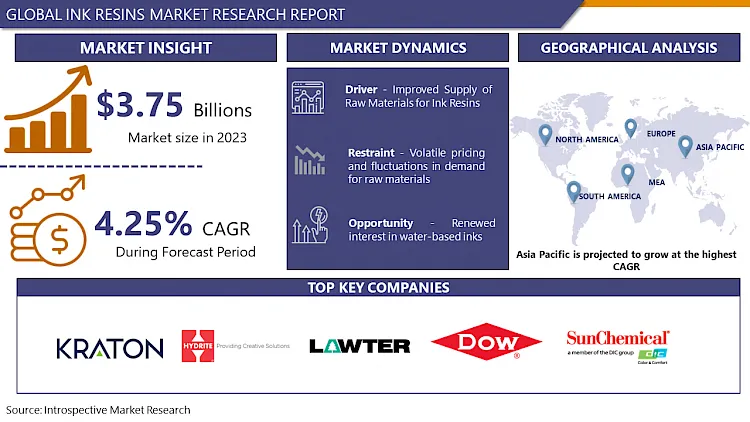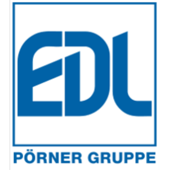Global Ink Resins Market Synopsis
Global Ink Resins Market Size Was Valued at USD 3.75 Billion in 2023, and is Projected to Reach USD 5.45 Billion by 2032, Growing at a CAGR of 4.25% From 2024-2032.
The Ink Resins Market is set to experience substantial growth, fueled by the rising need for high-performance printing inks in the packaging, commercial, and digital printing sectors. The market is experiencing a change towards eco-friendly and sustainable ink resins, along with improvements in digital printing technologies, which are projected to boost market growth even more. The demand for Ink Resins is anticipated to surge in the upcoming years due to the growing popularity of e-commerce and the requirement for stronger packaging. The increasing utilization of ink resins in the labels and packaging industry is also predicted to aid in the market's expansion. In general, the Ink Resins Market is projected to undergo a notable increase, propelled by technological advancements and the increasing need for flexible and eco-friendly printing options.
- Resins are essential components adopted in producing various types of inks used in packaging industries. Furthermore, increasing e-commerce business globally is turning demand for packaging solutions further fueling the growth of the market. Lithographic, flexographic, inkjet, offset, and sheet-fed printing are some other examples that deploy these resins which are anticipated to drive ink resins market growth during the projected period.
- Ink resins are used in the production of printing inks. They are used in pigments and scattering of the inks to change the property of the end product. Growing demand for packaged food and beverages is anticipated to be a key contributing factor to ink resins market growth during the forecast period.

Global Ink Resins Market Trend Analysis
Improved Supply of Raw Materials for Ink Resins
- The enhanced supply of raw materials for ink resins stands as a pivotal driving force propelling the growth of the Global Ink Resins Market. This surge in raw material availability has substantially alleviated historical constraints and bottlenecks within the ink resin manufacturing sector. With a more stable and accessible resource base, manufacturers now enjoy greater flexibility and reliability in their production processes. This has led to a more consistent quality of ink resins and a broader spectrum of offerings catering to diverse industry demands.
- The improved raw material supply has fostered innovation within the sector. Manufacturers are now able to experiment with new formulations and develop advanced ink resin varieties. This not only bolsters product quality but also enables the creation of specialized inks with enhanced properties such as improved adhesion, durability, and eco-friendliness. As a result, the market experiences a surge in demand for these high-performance ink solutions across various application domains, further amplifying market growth.
- The stabilized and improved raw material supply chain has also contributed significantly to cost optimization within the ink resin industry. With a steady influx of essential components, manufacturers can better manage production costs, ensuring a more competitive pricing strategy. This cost-efficiency factor not only benefits manufacturers but also resonates positively with consumers and downstream industries, fostering increased adoption and consumption of ink resins globally.
Renewed interest in water-based inks
- The resurgence of interest in water-based inks presents a significant opportunity for the Global Ink Resins Market. This renewed attention is primarily fueled by the growing environmental consciousness and stringent regulatory measures aimed at reducing volatile organic compounds (VOCs) and hazardous emissions. Water-based inks offer a eco-friendlier alternative, characterized by lower VOC content and reduced environmental impact compared to solvent-based counterparts. As sustainability becomes a key focus across industries, the shift toward water-based inks presents a substantial growth avenue for ink resin manufacturers.
- The technological advancements in water-based ink formulations have significantly improved their performance characteristics. Modern water-based inks now boast enhanced color vibrancy, improved adhesion, and increased durability, rivaling the quality and versatility of solvent-based inks. This advancement paves the way for broader applications across packaging, labels, textiles, and other industries, expanding the market potential for ink resins catering to water-based ink formulations.
Global Ink Resins Market Segment Analysis:
Global Ink Resins Market Segmented on the basis of type, application, and end-users.
By Resin Type, Modified Rosins segment is expected to dominate the market during the forecast period
- Modified rosins represent a burgeoning segment within the resin industry, showing robust growth due to their versatile applications and enhanced properties. These modified forms of natural rosin, extracted from pine trees, undergo chemical alterations to tailor their characteristics for specific industrial needs. This customization allows manufacturers to create resins with improved solubility, adhesion, flexibility, and compatibility with various substrates, thereby broadening their utility across multiple sectors.
- The growth in demand for modified rosins stems from several factors. Firstly, their adaptability makes them highly sought-after in adhesive formulations, where these resins offer superior bonding properties in diverse applications such as packaging, construction, and automotive industries. Their ability to improve the adhesive's performance under different conditions, including temperature variations and exposure to various surfaces, contributes to their rising popularity.
By Technology, UV-curable segment held the largest share of 5.2% in 2022
- UV-curable inks represent a transformative innovation in the printing industry, driving significant advancements in print technology. These inks, cured instantly by exposure to ultraviolet (UV) light, offer numerous advantages over traditional solvent or water-based inks. Their rapid curing process results in almost immediate drying, enabling faster production speeds and reduced production time. This characteristic makes them highly efficient, especially in high-speed printing applications, such as packaging and labeling, where quick turnaround times are essential.
- The unique chemistry of UV-curable inks allows them to bond instantly with the substrate upon exposure to UV light. This results in prints with exceptional durability, scratch resistance, and vibrant colors. Their ability to adhere to a wide range of materials, including plastics, glass, metal, and paper, makes them versatile for various printing applications across industries. Additionally, their low volatile organic compound (VOC) content contributes to their eco-friendly profile, aligning with the increasing demand for sustainable printing solutions.
Global Ink Resins Market Regional Insights:
Asia Pacific is Expected to Dominate the Market Over the Forecast period
- Fueled by booming economies in China, India, and a few smaller countries, the ink industry is growing. In particular, the packaging sector offers opportunities as manufacturers and global packaging converters expand to the region. Growth of the printing inks industry varied throughout the Asia Pacific region, with China witnessing the highest increase at 10%. Inkjet printing is on the rise in the Asia Pacific and is growing at a high rate throughout the region, both, in industrial segments such as wide format signage as well as in personal use. Apart from personal use, inkjet inks have an increasing demand from the wide format markets in India and Australia.
Global Ink Resins Market Top Key Players:
-
Kraton Chemical Ltd (U.S.)
- Hydrite Chemical (U.S.)
- Lawter B.V. (U.S.)
- The Dow Chemical Company (U.S.)
- Sun Chemical(U.S.)
- Huntsman Corporation (U.S.)
- Emerald Performance Materials (U.S.)
- Celanese Corporation (U.S.)
- Wacker Chemie AG(Germany)
- BASF SE (Germany)
- Evonik Tego Chemie GmbH (Germany)
- Covestro AG (Germany),
- Indulor (Germany)
- Lanxess (Germany)
- IGM Resins (Netherlands)
- DSM (Netherlands)
- Flint Group (Netherlands)
- Arakawa Chemical (Japan)
- Nippon Steel Chemical Co., Ltd. (Japan)
- DIC Corporation (Japan)
- Royal DSM N.V. (Netherlands)
- SK Chemicals Co., Ltd. (South Korea)
- LOTTE Chemical Corporation (South Korea)
- Jilin Chemical Industry Group Co., Ltd. (China)
- Sinopec Corporation (China)
|
Global Ink Resins Market |
|||
|
Base Year: |
2023 |
Forecast Period: |
2024-2032 |
|
Historical Data: |
2017 to 2023 |
Market Size in 2023: |
USD 3.6 Bn. |
|
Forecast Period 2024-32 CAGR: |
4.25% |
Market Size in 2032: |
USD 5.02 Bn. |
|
Segments Covered: |
By Resin Type |
|
|
|
By Technology |
|
||
|
By Application |
|
||
|
By Region |
|
||
|
Key Market Drivers: |
|
||
|
Key Market Restraints: |
|
||
|
Key Opportunities: |
|
||
|
Companies Covered in the report: |
|
||
- INTRODUCTION
- RESEARCH OBJECTIVES
- RESEARCH METHODOLOGY
- RESEARCH PROCESS
- SCOPE AND COVERAGE
- Market Definition
- Key Questions Answered
- MARKET SEGMENTATION
- EXECUTIVE SUMMARY
- MARKET OVERVIEW
- GROWTH OPPORTUNITIES BY SEGMENT
- MARKET LANDSCAPE
- PORTER’S FIVE FORCES ANALYSIS
- Bargaining Power Of Supplier
- Threat Of New Entrants
- Threat Of Substitutes
- Competitive Rivalry
- Bargaining Power Among Buyers
- INDUSTRY VALUE CHAIN ANALYSIS
- MARKET DYNAMICS
- Drivers
- Restraints
- Opportunities
- Challenges
- MARKET TREND ANALYSIS
- REGULATORY LANDSCAPE
- PESTLE ANALYSIS
- PRICE TREND ANALYSIS
- PATENT ANALYSIS
- TECHNOLOGY EVALUATION
- MARKET IMPACT OF THE RUSSIA-UKRAINE WAR
- Geopolitical Market Disruptions
- Supply Chain Disruptions
- Instability in Emerging Markets
- ECOSYSTEM
- PORTER’S FIVE FORCES ANALYSIS
- INK RESINS MARKET BY RESIN TYPE (2017-2032)
- INK RESINS MARKET SNAPSHOT AND GROWTH ENGINE
- MARKET OVERVIEW
- MODIFIED ROSINS
- Introduction And Market Overview
- Historic And Forecasted Market Size in Value (2017-2032F)
- Historic And Forecasted Market Size in Volume (2017-2032F)
- Key Market Trends, Growth Factors And Opportunities
- Geographic Segmentation Analysis
- HYDROCARBON
- MODIFIED CELLULOSE
- INK RESINS MARKET BY TECHNOLOGY (2017-2032)
- INK RESINS MARKET SNAPSHOT AND GROWTH ENGINE
- MARKET OVERVIEW
- OIL
- Introduction And Market Overview
- Historic And Forecasted Market Size in Value (2017-2032F)
- Historic And Forecasted Market Size in Volume (2017-2032F)
- Key Market Trends, Growth Factors And Opportunities
- Geographic Segmentation Analysis
- SOLVENT
- WATER
- UV-CURABLE
- INK RESINS MARKET BY APPLICATION (2017-2032)
- INK RESINS MARKET SNAPSHOT AND GROWTH ENGINE
- MARKET OVERVIEW
- PRINTING & PUBLICATION
- Introduction And Market Overview
- Historic And Forecasted Market Size in Value (2017-2032F)
- Historic And Forecasted Market Size in Volume (2017-2032F)
- Key Market Trends, Growth Factors And Opportunities
- Geographic Segmentation Analysis
- FLEXIBLE PACKAGING
- CORRUGATED CARDBOARDS & CARTONS
- COMPANY PROFILES AND COMPETITIVE ANALYSIS
- COMPETITIVE LANDSCAPE
- Competitive Positioning
- Ink Resins Market Share By Manufacturer (2022)
- Industry BCG Matrix
- Heat Map Analysis
- Mergers & Acquisitions
- ARIZONA CHEMICAL
- Company Overview
- Key Executives
- Company Snapshot
- Role of the Company in the Market
- Sustainability and Social Responsibility
- Operating Business Segments
- Product Portfolio
- Business Performance (Production Volume, Sales Volume, Sales Margin, Production Capacity, Capacity Utilization Rate)
- Key Strategic Moves And Recent Developments
- SWOT Analysis
- Hydrite Chemical
- Lawter B.V.
- The Dow Chemical Company
- Sun Chemical
- Huntsman Corporation
- Emerald Performance Materials
- Celanese Corporation
- Wacker Chemie AG
- BASF SE
- Evonik Tego Chemie GmbH
- Covestro AG
- Indulor
- Lanxess
- IGM Resins
- DSM
- Flint Group
- Arakawa Chemical
- Nippon Steel Chemical Co., Ltd.
- DIC Corporation
- COMPETITIVE LANDSCAPE
- GLOBAL INK RESINS MARKET BY REGION
- OVERVIEW
- NORTH AMERICA
- Key Market Trends, Growth Factors And Opportunities
- Key Manufacturers
- Historic And Forecasted Market Size By Resin Type
- Historic And Forecasted Market Size By Technology
- Historic And Forecasted Market Size By Application
- Historic And Forecasted Market Size By Country
- USA
- Canada
- Mexico
- EASTERN EUROPE
- Key Market Trends, Growth Factors And Opportunities
- Key Manufacturers
- Historic And Forecasted Market Size By Segments
- Historic And Forecasted Market Size By Country
- Russia
- Bulgaria
- The Czech Republic
- Hungary
- Poland
- Romania
- Rest Of Eastern Europe
- WESTERN EUROPE
- Key Market Trends, Growth Factors And Opportunities
- Key Manufacturers
- Historic And Forecasted Market Size By Segments
- Historic And Forecasted Market Size By Country
- Germany
- United Kingdom
- France
- The Netherlands
- Italy
- Spain
- Rest Of Western Europe
- ASIA PACIFIC
- Key Market Trends, Growth Factors And Opportunities
- Key Manufacturers
- Historic And Forecasted Market Size By Segments
- Historic And Forecasted Market Size By Country
- China
- India
- Japan
- South Korea
- Malaysia
- Thailand
- Vietnam
- The Philippines
- Australia
- New-Zealand
- Rest Of APAC
- MIDDLE EAST & AFRICA
- Key Market Trends, Growth Factors And Opportunities
- Key Manufacturers
- Historic And Forecasted Market Size By Segments
- Historic And Forecasted Market Size By Country
- Turkey
- Bahrain
- Kuwait
- Saudi Arabia
- Qatar
- UAE
- Israel
- South Africa
- SOUTH AMERICA
- Key Market Trends, Growth Factors And Opportunities
- Key Manufacturers
- Historic And Forecasted Market Size By Segments
- Historic And Forecasted Market Size By Country
- Brazil
- Argentina
- Rest of South America
- INVESTMENT ANALYSIS
- ANALYST VIEWPOINT AND CONCLUSION
- Recommendations and Concluding Analysis
- Potential Market Strategies
|
Global Ink Resins Market |
|||
|
Base Year: |
2023 |
Forecast Period: |
2024-2032 |
|
Historical Data: |
2017 to 2023 |
Market Size in 2023: |
USD 3.6 Bn. |
|
Forecast Period 2024-32 CAGR: |
4.25% |
Market Size in 2032: |
USD 5.02 Bn. |
|
Segments Covered: |
By Resin Type |
|
|
|
By Technology |
|
||
|
By Application |
|
||
|
By Region |
|
||
|
Key Market Drivers: |
|
||
|
Key Market Restraints: |
|
||
|
Key Opportunities: |
|
||
|
Companies Covered in the report: |
|
||
Frequently Asked Questions :
The forecast period in the Global Ink Resins Market research report is 2024-2032.
Arizona Chemical, Hydrite Chemical, Lawter B.V., The Dow Chemical Company, Sun Chemical, Huntsman Corporation, Emerald Performance Materials, Celanese Corporation, Wacker Chemie AG, BASF SE, Evonik Tego Chemie GmbH, Covestro AG, Indulor, Lanxess, IGM Resins, DSM, Flint Group, Arakawa Chemical, Nippon Steel Chemical Co., Ltd., DIC Corporation, Royal DSM N.V., SK Chemicals Co., Ltd., LOTTE Chemical Corporation, Jilin Chemical Industry Group Co., Ltd., Sinopec Corporation and Other Major Players.
The Global Ink Resins Market is segmented into Resin Type, Technology, Application, and region. By Resin Type, the market is categorized into Modified Rosins, Hydrocarbon, Modified Cellulose. By Technology, the market is categorized into Oil, Solvent, Water, UV-curable. By Application, the market is categorized into Printing & Publication, Flexible Packaging, Corrugated Cardboards & Cartons. By region, it is analyzed across North America (U.S.; Canada; Mexico), Eastern Europe (Bulgaria; The Czech Republic; Hungary; Poland; Romania; Rest of Eastern Europe), Western Europe (Germany; UK; France; Netherlands; Italy; Russia; Spain; Rest of Western Europe), Asia-Pacific (China; India; Japan; Southeast Asia, etc.), South America (Brazil; Argentina, etc.), Middle East & Africa (Saudi Arabia; South Africa, etc.).
Ink resin is a raw material used for the production of printing inks. Ink resins are used in pigments and ink scattering to alter end products properties. Shine, dilatability attractive surface appearance, consistency, liquidity, and flow are important properties that make these resins popular over a variety of end-use applications
Global Ink Resins Market Size Was Valued at USD 3.75 Billion in 2023, and is Projected to Reach USD 5.45 Billion by 2032, Growing at a CAGR of 4.25% From 2024-2032.















